Are Torque-Driven Simulation Models of Human Movement Limited by an Assumption of Monoarticularity?
Abstract
:1. Introduction
2. Methods
2.1. Model Evaluation
3. Results
3.1. Squat Jump
3.2. Countermovement Jump
3.3. Work Done
4. Discussion
Author Contributions
Funding
Institutional Review Board Statement
Informed Consent Statement
Data Availability Statement
Conflicts of Interest
References
- King, M.A.; Yeadon, M.R. Maximising somersault rotation in tumbling. J. Biomech. 2004, 37. [Google Scholar] [CrossRef] [PubMed] [Green Version]
- Wilson, C.; Yeadon, M.R.; King, M.A. Considerations that affect optimised simulation in a running jump for height. J. Biomech. 2007, 40. [Google Scholar] [CrossRef] [Green Version]
- Allen, S.J.; King, M.A.; Yeadon, M.R. Is a single or double arm technique more advantageous in triple jumping? J. Biomech. 2010, 43. [Google Scholar] [CrossRef] [Green Version]
- Hiley, M.J.; Jackson, M.I.; Yeadon, M.R. Optimal technique for maximal forward rotating vaults in men’s gymnastics. Hum. Mov. Sci. 2015, 42, 117–131. [Google Scholar] [CrossRef] [PubMed] [Green Version]
- Lloyd, D.G.; Besier, T.F. An EMG-driven musculoskeletal model to estimate muscle forces and knee joint moments in vivo. J. Biomech. 2003, 36, 765–776. [Google Scholar] [CrossRef]
- Yeadon, M.R.; King, M.A. Computer simulation modelling in sport. In Biomechanical Evaluation of Movement in Sport and Exercise: BASES Guidelines; Payton, C.J., Bartlett, R.M., Eds.; Routledge: London, UK, 2018; pp. 176–205. [Google Scholar]
- King, M.A.; Yeadon, M.R. Advances in the development of whole body computer simulation modelling of sports technique. Mov. Sport. Sci. Sci. Mot. 2015, 43. [Google Scholar] [CrossRef] [Green Version]
- Wilson, C.; King, M.A.; Yeadon, M.R. The effects of initial conditions and takeoff technique on running jumps for height and distance. J. Biomech. 2011, 44. [Google Scholar] [CrossRef] [PubMed] [Green Version]
- Allen, S.J.; King, M.A.; Yeadon, M.R. Optimisation of phase ratio in the triple jump using computer simulation. Hum. Mov. Sci. 2016, 46. [Google Scholar] [CrossRef] [Green Version]
- King, M.A.; Kong, P.W.; Yeadon, M.R. Maximising forward somersault rotation in springboard diving. J. Biomech. 2019, 85. [Google Scholar] [CrossRef] [Green Version]
- Lewis, M.G.C.; Yeadon, M.R.; King, M.A. The effect of accounting for biarticularity in hip flexor and hip extensor joint torque representations. Hum. Mov. Sci. 2017. [Google Scholar] [CrossRef] [PubMed]
- Ashby, B.M.; Delp, S.L. Optimal control simulations reveal mechanisms by which arm movement improves standing long jump performance. J. Biomech. 2006, 39, 1726–1734. [Google Scholar] [CrossRef]
- Cheng, K.B.; Wang, C.-H.; Chen, H.-C.; Wu, C.-D.; Chiu, H.-T. The mechanisms that enable arm motion to enhance vertical jump performance—A simulation study. J. Biomech. 2008, 41, 1847–1854. [Google Scholar] [CrossRef] [PubMed]
- Selbie, W.S.; Caldwell, G.E. A simulation study of vertical jumping from different starting postures. J. Biomech. 1996, 29, 1137–1146. [Google Scholar] [CrossRef]
- Yeadon, M.R.; King, M.A.; Wilson, C. Modelling the maximum voluntary joint torque/angular velocity relationship in human movement. J. Biomech. 2006, 39. [Google Scholar] [CrossRef] [PubMed] [Green Version]
- Forrester, S.E.; Yeadon, M.R.; King, M.A.; Pain, M.T.G. Comparing different approaches for determining joint torque parameters from isovelocity dynamometer measurements. J. Biomech. 2011, 44. [Google Scholar] [CrossRef] [Green Version]
- Gordon, A.M.; Huxley, A.F.; Julian, F.J. The variation in isometric tension with sarcomere length in vertebrate muscle fibres. J. Physiol. 1966, 184, 170–192. [Google Scholar] [CrossRef]
- Fenn, W.O.; Marsh, B.S. Muscular force at different speeds of shortening. J. Physiol. 1935, 85, 277–297. [Google Scholar] [CrossRef]
- Hill, A.V. The heat of shortening and the dynamic constants of muscle. Proc. R. Soc. Lond. Ser. B Biol. Sci. 1938, 126, 136–195. [Google Scholar] [CrossRef]
- Katz, B. The relation between force and speed in muscular contraction. J. Physiol. 1939, 96, 45–64. [Google Scholar] [CrossRef] [PubMed]
- van Soest, A.J.; Schwab, A.L.; Bobbert, M.F.; van Ingen Schenau, G.J. The influence of the biarticularity of the gastrocnemius muscle on vertical-jumping achievement. J. Biomech. 1993, 26, 1–8. [Google Scholar] [CrossRef]
- Böhm, H.; Cole, G.K.; Brüggemann, G.-P.; Ruder, H. Contribution of muscle series elasticity to maximum performance in drop jumping. J. Appl. Biomech. 2006, 22, 3–13. [Google Scholar] [CrossRef] [PubMed]
- Bisseling, R.W.; Hof, A.L. Handling of impact forces in inverse dynamics. J. Biomech. 2006, 39, 2438–2444. [Google Scholar] [CrossRef]
- Hof, A.L. The force resulting from the action of mono- and biarticular muscles in a limb. J. Biomech. 2001, 34, 1085–1089. [Google Scholar] [CrossRef] [Green Version]
- Jones, S.L.; Caldwell, G.E. Mono- and Biarticular Muscle Activity during Jumping in Different Directions. J. Appl. Biomech. 2003, 19, 205–222. [Google Scholar] [CrossRef] [Green Version]
- Kuo, A.D. The action of two-joint muscles: The legacy of W.P. Lombard, in Classics in Movement Science. In Classics in Movement Science; Latash, M.L., Zatsiorsky, V.M., Eds.; Human Kinetics: Champaign, IL, USA, 2001; pp. 289–315. [Google Scholar]
- Doorenbosch, C.A.M.; van Ingen Schenau, G.J. The role of mono- and bi-articular muscles during contact control leg tasks in man. Hum. Mov. Sci. 1995, 14, 279–300. [Google Scholar] [CrossRef]
- Shinohara, M.; Yoshitake, Y.; Kouzaki, M.; Fukunaga, T. The medial gastrocnemius muscle attenuates force fluctuations during plantar flexion. Exp. Brain Res. 2006, 169, 15–23. [Google Scholar] [CrossRef]
- King, M.A.; Lewis, M.G.C.; Yeadon, M.R. Is it necessary to include biarticular effects within joint torque representations of knee flexion and knee extension? Int. J. Multiscale Comput. Eng. 2012, 10. [Google Scholar] [CrossRef]
- Lewis, M.G.C.; King, M.A.; Yeadon, M.R.; Conceição, F. Are joint torque models limited by an assumption of monoarticularity? J. Appl. Biomech. 2012, 28, 520–529. [Google Scholar] [CrossRef] [Green Version]
- King, M.A.; Wilson, C.; Yeadon, M.R. Evaluation of a torque-driven model of jumping for height. J. Appl. Biomech. 2006, 22, 264–274. [Google Scholar] [CrossRef] [Green Version]
- Kane, T.R.; Levinson, D.A. Dynamics, Theory and Applications; McGraw Hill: New York, NY, USA, 1985; ISBN 0-07-037846-0. [Google Scholar]
- Yeadon, M.R.; Kong, P.W.; King, M.A. Parameter determination for a computer simulation model of a diver and a springboard. J. Appl. Biomech. 2006, 22, 167–176. [Google Scholar] [CrossRef] [PubMed] [Green Version]
- Tillin, N.A.; Jimenez-Reyes, P.; Pain, M.T.G.; Folland, J.P. Neuromuscular Performance of Explosive Power Athletes versus Untrained Individuals. Med. Sci. Sport. Exerc. 2010, 42, 781–790. [Google Scholar] [CrossRef] [Green Version]
- Kooistra, R.D.; de Ruiter, C.J.; de Haan, A. Conventionally assessed voluntary activation does not represent relative voluntary torque production. Eur. J. Appl. Physiol. 2007, 100, 309–320. [Google Scholar] [CrossRef] [Green Version]
- Riener, R.; Edrich, T. Identification of passive elastic joint moments in the lower extremities. J. Biomech. 1999, 32, 539–544. [Google Scholar] [CrossRef]
- Yeadon, M.R. The simulation of aerial movement—II. A mathematical inertia model of the human body. J. Biomech. 1990, 23, 67–74. [Google Scholar] [CrossRef] [Green Version]
- Yeadon, M.R.; King, M.A. Evaluation of a torque-driven simulation model of tumbling. J. Appl. Biomech. 2002, 18, 195–206. [Google Scholar] [CrossRef] [Green Version]
- Carroll, D.L. Genetic algorithms and optimizing chemical oxygen-iodine lasers. Dev. Theor. Appl. Mech. 1996, 18, 411–424. [Google Scholar]
- Edman, K.A. Double-hyperbolic force-velocity relation in frog muscle fibres. J. Physiol. 1988, 404, 301–321. [Google Scholar] [CrossRef]
- Pandy, M.G.; Zajac, F.E.; Sim, E.; Levine, W.S. An optimal control model for maximum-height human jumping. J. Biomech. 1990, 23, 1185–1198. [Google Scholar] [CrossRef]
- Anderson, F.C.; Pandy, M.G. A dynamic optimization solution for vertical jumping in three dimensions. Comput. Methods Biomech. Biomed. Engin. 1999, 2, 201–231. [Google Scholar] [CrossRef]
- Nagano, A.; Komura, T.; Fukashiro, S.; Himeno, R. Force, work and power output of lower limb muscles during human maximal-effort countermovement jumping. J. Electromyogr. Kinesiol. 2005, 15, 367–376. [Google Scholar] [CrossRef] [PubMed]
- Bobbert, M.F.; Gerritsen, K.G.M.; Litjens, M.C.A.; Van Soest, A.J. Why is countermovement jump height greater than squat jump height? Med. Sci. Sports Exerc. 1996, 28, 1402–1412. [Google Scholar] [CrossRef] [PubMed]
- Spägele, T.; Kistner, A.; Gollhofer, A. Modelling, simulation and optimisation of a human vertical jump. J. Biomech. 1999, 32, 521–530. [Google Scholar] [CrossRef]
- Bisele, M.; Bencsik, M.; Lewis, M.G.C.; Barnett, C.T. Optimisation of a machine learning algorithm in human locomotion using principal component and discriminant function analyses. PLoS ONE 2017, 12, e0183990. [Google Scholar] [CrossRef] [PubMed] [Green Version]
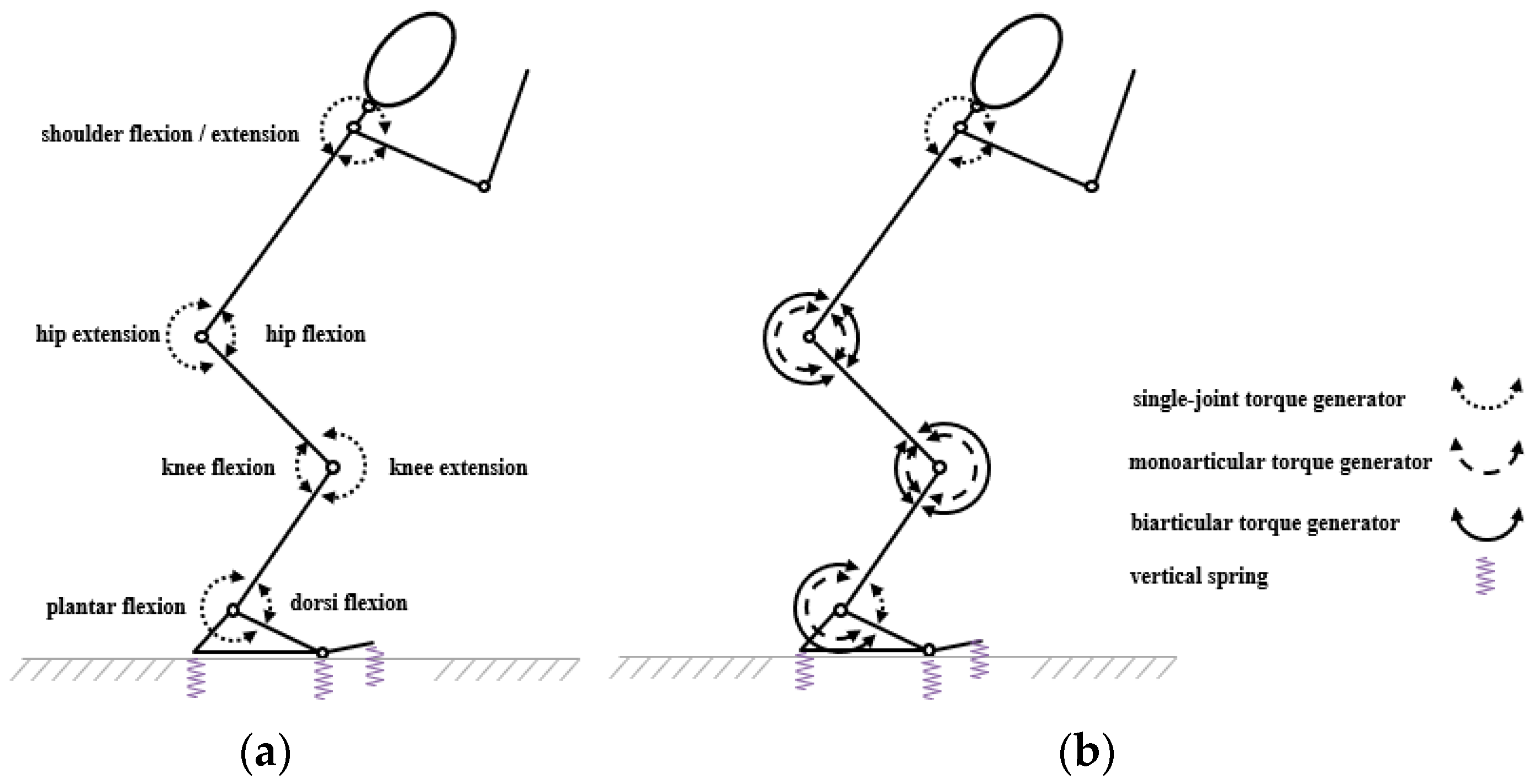
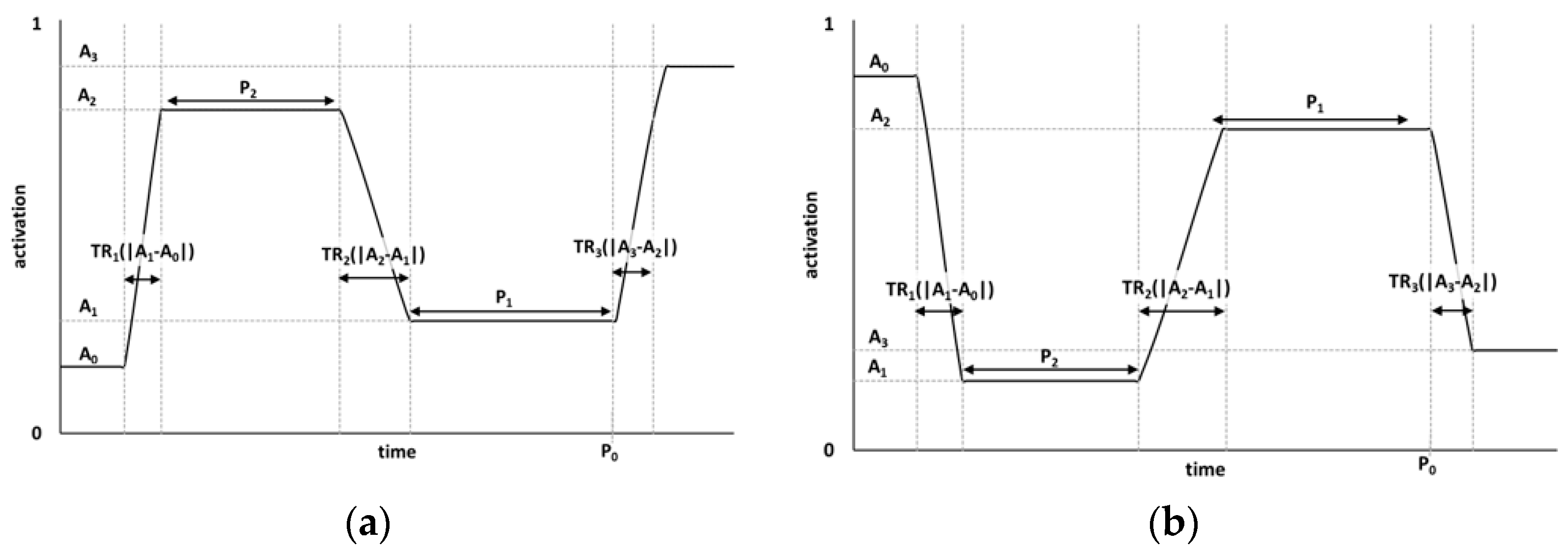
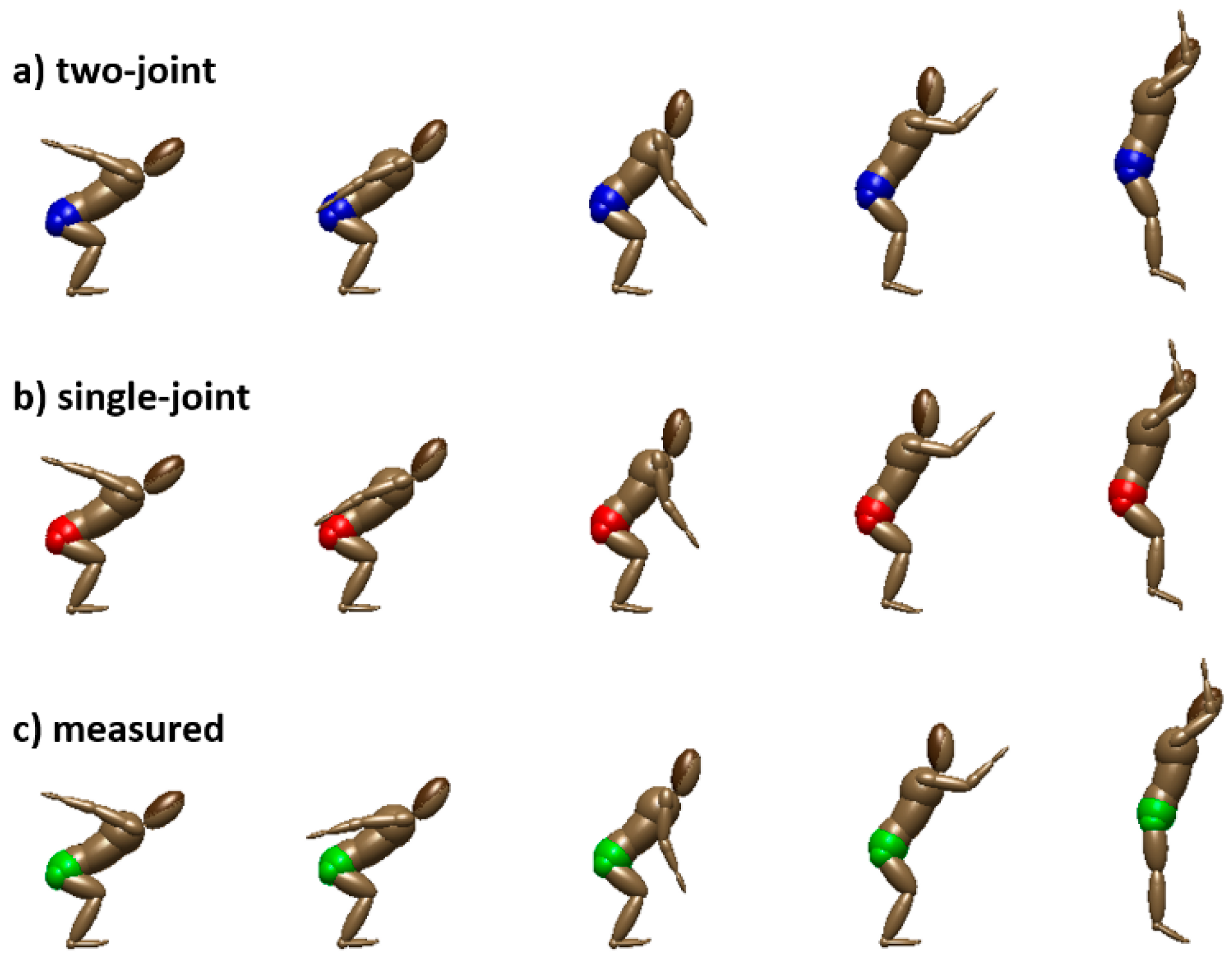

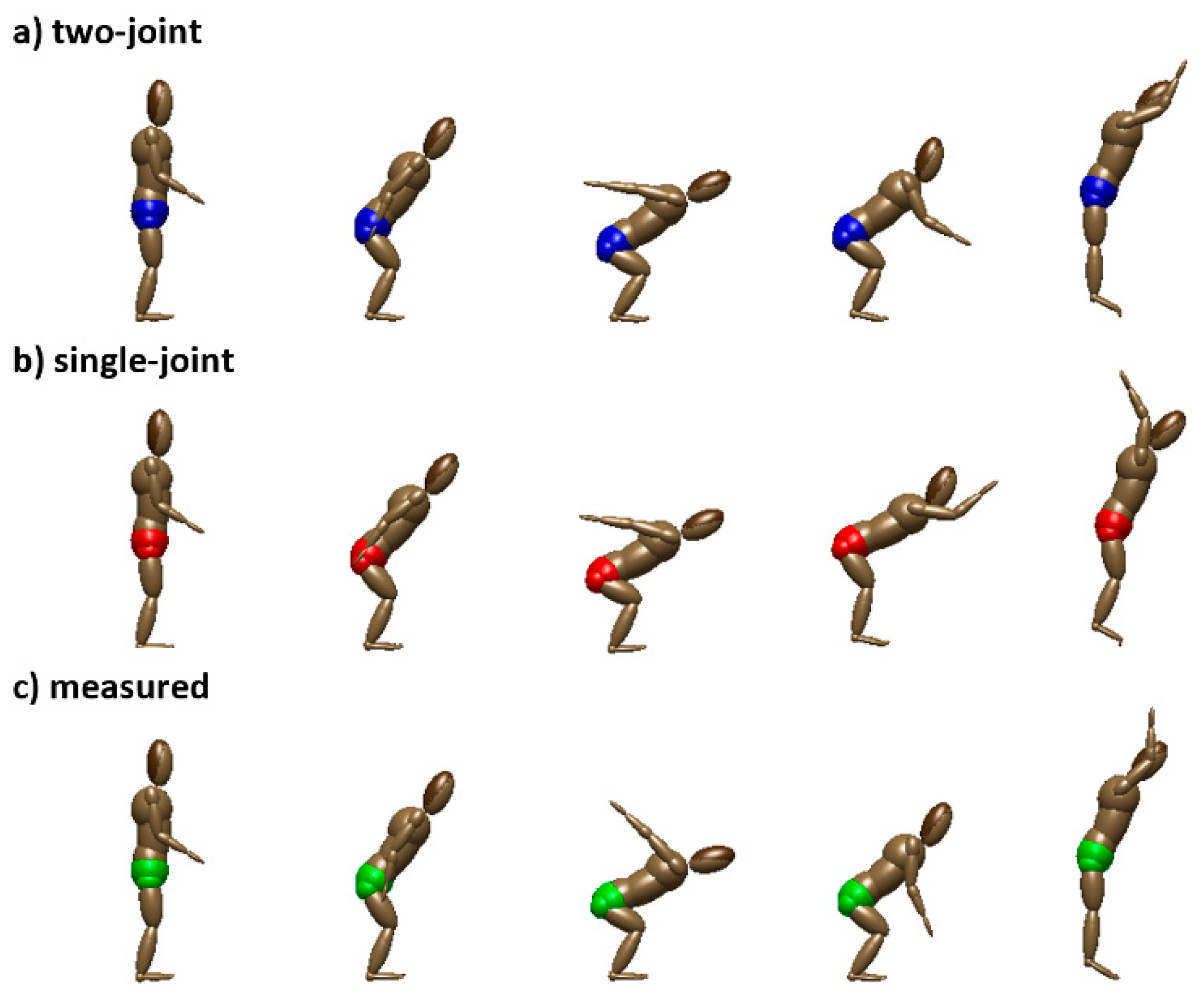
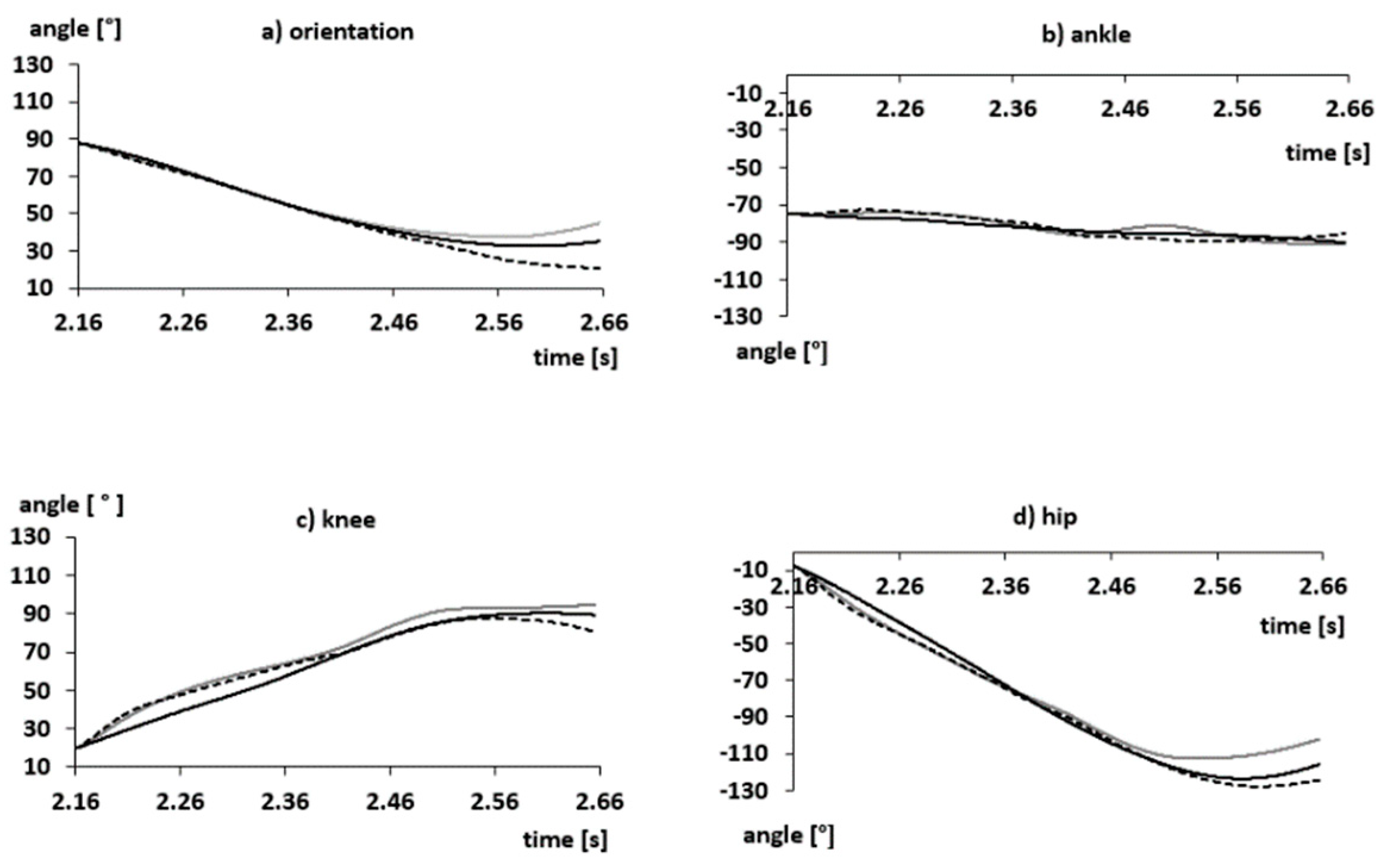
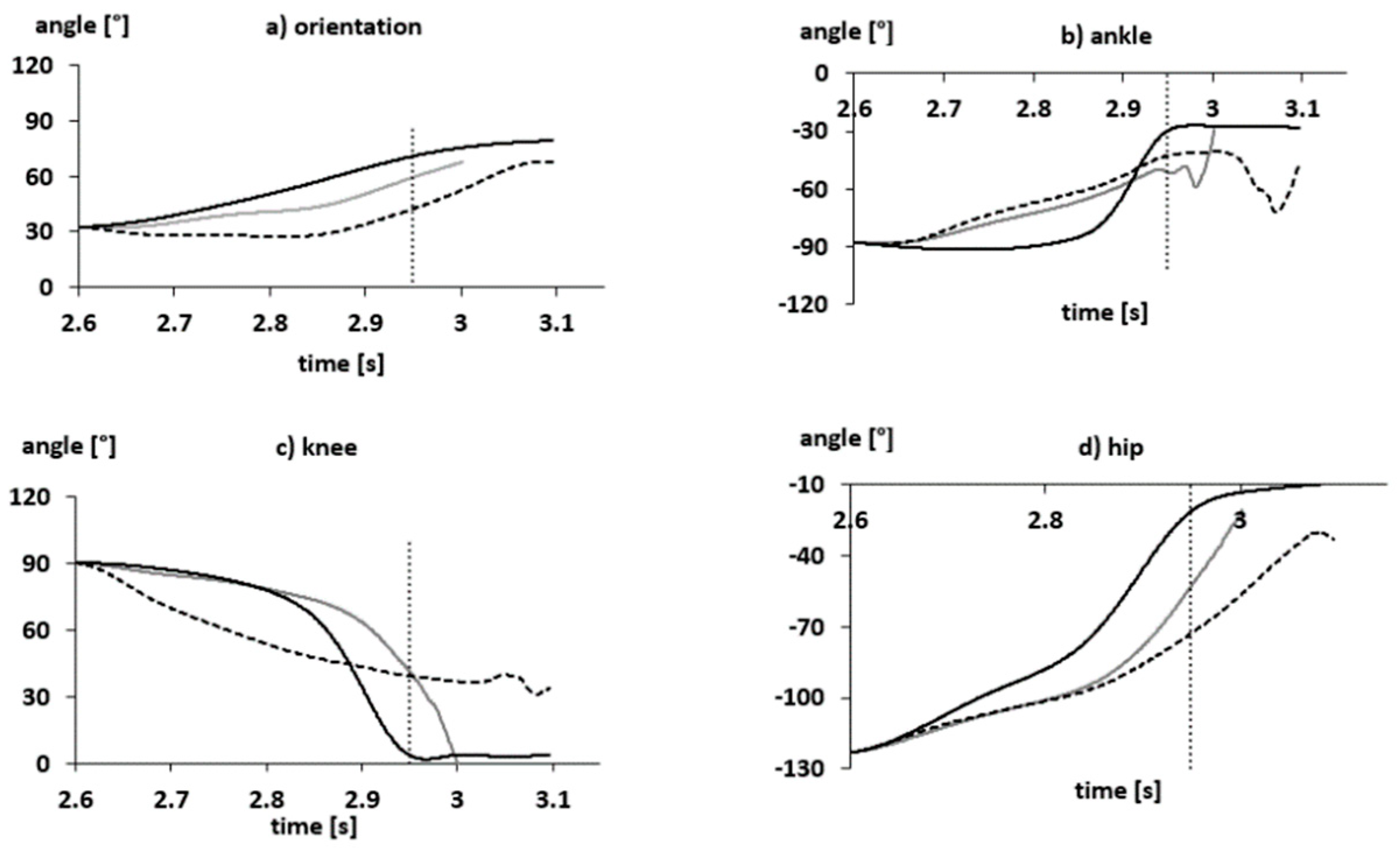
| Angle and Definition | +ve Angular Velocity | Squat Jump | Countermovement Jump | ||
|---|---|---|---|---|---|
| Angle | Angular Velocity | Angle | Angular Velocity | ||
| [°] | [°·s−1] | [°] | [°·s−1] | ||
| trunk angle from horizontal | anti-clockwise | 56 | 3 | 88 | −107 |
| MTP angle from full extension | flexion | 43 | 0 | 43 | −1 |
| ankle angle from full extension | plantar flexion | −90 | −4 | −75 | −43 |
| knee angle from full extension | flexion | 96 | −17 | 20 | 177 |
| hip angle from full extension | extension | −123 | 5 | −8 | −235 |
| shoulder angle from full extension | flexion | −60 | 97 | 11 | 104 |
| elbow angle from full extension | flexion | 20 | −13 | 50 | 71 |
| neck angle from full extension | flexion | −5 | −65 | 1 | −65 |
| (a) SJ | plantar flexion | dorsi flexion | knee flexion | knee extension | hip flexion | hip extension | shoulder flexion | shoulder extension |
| Tmax | 602.69 | 86.65 | 265.55 | 415.95 | 323.9 | 318.53 | 153.34 | 147.31 |
| T0 | 430.48 | 61.89 | 189.68 | 297.1 | 231.36 | 227.52 | 109.52 | 105.22 |
| ωmax | 20.26 | 6.87 | 18.2 | 17.86 | 9.99 | 11.87 | 16.42 | 15.1 |
| ωc | 4.45 | 3.43 | 9.1 | 2.68 | 3.81 | 5.81 | 8.21 | 6.28 |
| k2 | 0.85 | 1.95 | 0.39 | 1.64 | 0.5 | 0.37 | 0.04 | 0.1 |
| θopt | 4.89 | 2.38 | 3.12 | 4.22 | 3 | 4.85 | 7.1 | 5.92 |
| amin | 0.7 | 0.73 | 0.99 | 0.95 | 0.93 | 0.94 | 0.8 | 0.76 |
| m | 0.06 | 0.21 | 0.32 | 0.01 | 0.07 | 0.31 | 0.21 | 0.28 |
| ω1 | −0.11 | 1.11 | 47.6 | −1.1 | 1.33 | −0.61 | −9.74 | −5.16 |
| (b) TJ | plantar flexion | knee flexion | knee extension | hip flexion | hip extension | |||
| mono. | biart. | mono. | biart. | mono. | biart. | mono. | mono. | |
| Tmax | 432.1 | 276.29 | 129.63 | 159.65 | 399.92 | 126.29 | 317.87 | 213.5 |
| T0 | 308.64 | 197.34 | 92.59 | 114.03 | 285.66 | 90.21 | 227.07 | 152.5 |
| ωmax | 16.76 | 18.31 | 19.02 | 18.5 | 17.58 | 23.39 | 9.33 | 12.9 |
| ωc | 5.4 | 5.1 | 9.53 | 6.15 | 7.92 | 10.3 | 3.89 | 3.44 |
| k2 | 0.5 | 0.59 | 0.29 | 0.26 | 1.47 | 0.4 | 0.23 | 0.5 |
| θopt | 4.98 | 6.41 | 3.59 | 7.92 | 4.21 | 6.86 | 3.47 | 4.56 |
| amin | 0.71 | 0.84 | 0.96 | 0.82 | 0.99 | 0.64 | 0.87 | 0.99 |
| m | 0.06 | 0.04 | 0.3 | 0.28 | 0.06 | 0.83 | 0.13 | 0.02 |
| ω1 | −0.12 | −0.4 | 75.1 | 90 | −118 | 35 | 1.57 | −1.27 |
| R | 0.34 | 1.19 | 0.44 | |||||
| Segment | Length | Mass | Mass Centre Location | MOI |
|---|---|---|---|---|
| [m] | [kg] | [m] | [kg·m2] | |
| shank | 0.408 | 8.439 | 0.175 | 0.1054 |
| thigh | 0.406 | 21.577 | 0.171 | 0.3049 |
| trunk | 0.558 | 31.732 | 0.287 | 1.0231 |
| head | 0.339 | 7.075 | 0.172 | 0.0624 |
| upper arm | 0.275 | 5.345 | 0.12 | 0.0362 |
| forearm and hand | 0.408 | 3.21 | 0.148 | 0.0365 |
| (a) SJ | P0 [s] | TR3 [s] | A2 | A3 | strain at peak isometric torque |
| dorsi flexor | 3.825 | 1.724 | 0.044 | 0.026 | 0.051 |
| plantar flexor | 3.832 | 1.205 | 0.840 | 0.347 | 0.041 |
| knee extensor | 3.537 | 0.605 | 0.291 | 0.251 | 0.070 |
| knee flexor | 3.785 | 2.134 | 0.053 | 0.113 | 0.048 |
| hip flexor | 3.732 | 2.637 | 0.115 | 0.248 | 0.065 |
| hip extensor | 4.199 | 1.975 | 0.918 | 0.957 | 0.057 |
| shoulder flexor | 3.828 | 3.861 | 0.591 | 0.467 | 0.044 |
| shoulder extensor | 4.410 | 2.146 | 0.086 | 0.290 | 0.074 |
| MTP | 3.499 | 2.711 | 0.036 | 0.760 | |
| MTP (stiffness 600 Nm·rad−1, damping 7.18 Nms·rad−1, natural angle 2.27 rad), trunk angular velocity −0.073 rad·s−1 | |||||
| (b) TJ | P0 [s] | TR3 [s] | A2 | A3 | strain at peak isometric torque |
| dorsi flexor | 3.603 | 1.120 | 0.778 | 0.216 | 0.064 |
| plantar flexor (mono) | 3.791 | 0.172 | 0.536 | 0.862 | 0.067 |
| plantar flexor (biart) | 3.455 | 0.834 | 0.050 | 0.938 | 0.067 * |
| knee extensor (mono) | 3.491 | 1.945 | 0.382 | 0.612 | 0.053 |
| knee extensor (biart) | 4.443 | 1.592 | 0.946 | 0.274 | 0.053 * |
| knee flexor (mono) | 3.308 | 1.395 | 0.103 | 0.286 | 0.064 |
| knee flexor (biart) | 3.447 | 3.621 | 0.822 | 0.945 | 0.064 * |
| hip flexor (mono) | 3.458 | 0.400 | 0.018 | 0.077 | 0.045 |
| hip extensor (mono) | 4.337 | 0.775 | 0.961 | 0.623 | 0.048 |
| shoulder flexor | 4.162 | 2.707 | 0.838 | 0.170 | 0.066 |
| shoulder extensor | 3.961 | 3.741 | 0.105 | 0.310 | 0.041 |
| MTP | 3.823 | 0.969 | 0.015 | 0.200 | |
| MTP (stiffness 600 Nm·rad−1, damping 3.48 Nms·rad−1, natural angle 2.33 rad), trunk angular velocity −0.065 rad·s−1, * as for the monoarticular component | |||||
| (a) SJ | P0 [s] | P1 [s] | P2 [s] | TR1 [s] | TR2 [s] | TR3 [s] | A0 | A1 | A2 | A3 |
| dorsi flexor | 2.600 | 0.690 | 0.471 | 4.045 | 3.395 | 2.804 | 0.180 | 0.018 | 0.790 | 0.790 |
| plantar flexor | 2.600 | 0.035 | 0.134 | 0.365 | 0.142 | 2.498 | 0.195 | 0.266 | 0.931 | 0.931 |
| knee extensor | 2.600 | 0.003 | 0.496 | 1.728 | 0.050 | 1.368 | 0.780 | 0.186 | 0.691 | 0.691 |
| knee flexor | 2.600 | 0.167 | 0.246 | 0.919 | 0.642 | 0.795 | 0.431 | 0.199 | 0.806 | 0.806 |
| hip flexor | 2.600 | 0.053 | 0.092 | 1.395 | 0.151 | 1.607 | 0.685 | 0.963 | 0.010 | 0.010 |
| hip extensor | 2.600 | 0.026 | 0.421 | 1.205 | 0.199 | 1.450 | 0.948 | 0.199 | 0.889 | 0.889 |
| shoulder flexor | 2.600 | 0.813 | 0.689 | 0.611 | 1.588 | 0.088 | 0.086 | 0.998 | 0.229 | 0.229 |
| shoulder extensor | 2.600 | 0.021 | 0.627 | 1.557 | 0.063 | 1.172 | 0.819 | 0.353 | 0.010 | 0.010 |
| MTP | 2.600 | 0.923 | 0.516 | 0.690 | 0.801 | 0.760 | 0.249 | 0.532 | 0.010 | 0.010 |
| trunk angular velocity −1.967 rad·s−1 | ||||||||||
| (b) TJ | P0 [s] | P1 [s] | P2 [s] | TR1 [s] | TR2 [s] | TR3 [s] | A0 | A1 | A2 | A3 |
| dorsi flexor | 2.600 | 0.328 | 0.153 | 0.634 | 2.873 | 0.459 | 0.893 | 0.083 | 0.340 | 0.340 |
| plantar flexor (mono) | 2.600 | 0.853 | 0.807 | 2.306 | 2.148 | 3.161 | 0.605 | 0.623 | 0.089 | 0.089 |
| plantar flexor (biart) | 2.600 | 0.103 | 0.827 | 0.440 | 0.417 | 0.922 | 0.084 | 0.191 | 0.798 | 0.798 |
| knee extensor (mono) | 2.600 | 0.001 | 0.915 | 0.518 | 1.511 | 1.513 | 0.974 | 0.076 | 0.422 | 0.422 |
| knee extensor (biart) | 2.600 | 0.857 | 0.293 | 1.223 | 1.663 | 0.099 | 0.978 | 0.294 | 0.010 | 0.010 |
| knee flexor (mono) | 2.600 | 0.029 | 0.037 | 1.562 | 0.799 | 1.166 | 0.885 | 0.320 | 0.010 | 0.010 |
| knee flexor (biart) | 2.600 | 0.278 | 0.196 | 1.358 | 0.055 | 1.710 | 0.635 | 0.171 | 0.848 | 0.848 |
| hip flexor (mono) | 2.600 | 0.046 | 0.732 | 1.626 | 0.209 | 0.042 | 0.466 | 0.986 | 0.010 | 0.010 |
| hip extensor (mono) | 2.600 | 0.037 | 0.059 | 0.045 | 0.177 | 1.548 | 0.029 | 0.325 | 0.775 | 0.775 |
| shoulder flexor | 2.600 | 0.380 | 0.436 | 0.505 | 1.283 | 0.890 | 0.789 | 0.067 | 0.170 | 0.170 |
| shoulder extensor | 2.600 | 0.008 | 0.740 | 1.931 | 0.085 | 1.969 | 0.945 | 0.316 | 0.010 | 0.010 |
| MTP | 2.600 | 0.914 | 0.248 | 1.895 | 1.869 | 1.994 | 0.762 | 0.334 | 0.010 | 0.010 |
| trunk angular velocity −2.033 rad·s−1 | ||||||||||
| (a) SJ | P0[s] | TR3[s] | A2 | A3 | strain at peakisometric torque |
| dorsi flexor | 2.783 | 0.356 | 0.803 | 0.208 | 0.043 |
| plantar flexor | 2.910 | 1.971 | 0.931 | 0.996 | 0.050 |
| knee extensor | 2.724 | 1.287 | 0.691 | 0.955 | 0.054 |
| knee flexor | 3.326 | 0.274 | 0.806 | 0.368 | 0.080 |
| hip flexor | 3.027 | 1.738 | 0.089 | 0.190 | 0.068 |
| hip extensor | 3.152 | 1.050 | 0.955 | 0.992 | 0.047 |
| shoulder flexor | 3.103 | 0.988 | 0.229 | 0.704 | 0.043 |
| shoulder extensor | 2.733 | 0.906 | 0.010 | 0.924 | 0.041 |
| MTP | 3.792 | 1.580 | 0.452 | 0.438 | 0.043 |
| MTP (stiffness 600 Nm·rad−1, damping 1.28 Nms·rad−1, natural angle 2.43 rad), trunk angular velocity −0.295 rad·s−1 | |||||
| (b) TJ | P0[s] | TR3[s] | A2 | A3 | strain at peakisometric torque |
| dorsi flexor | 3.562 | 1.896 | 0.391 | 0.241 | 0.050 |
| plantar flexor (mono) | 2.636 | 1.090 | 0.089 | 0.580 | 0.051 |
| plantar flexor (biart) | 2.696 | 1.477 | 0.798 | 0.999 | 0.051 * |
| knee extensor (mono) | 2.783 | 0.246 | 0.422 | 0.906 | 0.076 |
| knee extensor (biart) | 3.657 | 0.653 | 0.496 | 0.709 | 0.076 * |
| knee flexor (mono) | 3.295 | 0.865 | 0.291 | 0.963 | 0.047 |
| knee flexor (biart) | 3.071 | 1.590 | 0.848 | 0.908 | 0.047 * |
| hip flexor (mono) | 3.629 | 0.785 | 0.182 | 0.682 | 0.051 |
| hip extensor (mono) | 2.864 | 1.546 | 0.775 | 0.754 | 0.044 |
| shoulder flexor | 3.643 | 0.084 | 0.185 | 0.928 | 0.060 |
| shoulder extensor | 3.468 | 0.255 | 0.482 | 0.751 | 0.045 |
| MTP | 3.465 | 1.836 | 0.275 | 0.197 | |
| MTP (stiffness 600 Nm·rad−1, damping 3.64 Nms·rad−1, natural angle 2.49 rad), trunk angular velocity −0.201 rad·s−1, * as for the monoarticular component | |||||
| Countermovement Jump | Squat Jump | |||||
|---|---|---|---|---|---|---|
| Descent | Ascent | |||||
| SJ | TJ | SJ | TJ | SJ | TJ | |
| kinematics | ||||||
| ankle (°) | 2.74 | 2.40 | 21.38 | 14.84 | 15.93 | 18.18 |
| knee (°) | 4.61 | 5.38 | 27.78 | 19.38 | 22.29 | 9.86 |
| hip (°) | 4.11 | 8.74 | 33.18 | 20.62 | 20.14 | 11.32 |
| shoulder (°) | 19.79 | 18.21 | 30.54 | 11.48 | 6.67 | 9.89 |
| MTP (°) | 5.00 | 6.65 | 24.41 | 18.48 | 22.73 | 20.55 |
| orientation (°) | 5.32 | 3.46 | 20.78 | 9.34 | 3.49 | 2.56 |
| kinematics only | 9.04 | 9.12 | 26.74 | 16.23 | 16.98 | 13.44 |
| other | ||||||
| vertical GRF (%) | 11.17 | 11.30 | - | - | - | - |
| vert. velocity at take-off (%) | - | - | 17.83 | 2.39 | 15.48 | 1.80 |
| contact time (%) | - | - | 42.00 | 15.09 | 0.56 | 0.31 |
| rotation potential (°) | - | - | 11.88 | 1.27 | 0.08 | 0.07 |
| orientation at take-off (°) | - | - | 2.71 | 2.99 | 0.14 | 1.71 |
| outcome $ | ||||||
| mass centre height at take-off (m) | - | - | 1.13 | 1.14 | 1.03 | 1.10 |
| jump height (m) | - | - | 0.26 | 0.36 | 0.25 | 0.34 |
| peak of jump height (m) | - | - | 1.38 | 1.50 | 1.28 | 1.44 |
| overall difference (%) | 9.38 | 9.46 | 24.27 | 10.07 | 10.28 | 6.11 |
| Single-Joint (SJ) | Two-Joint (TJ) | |||||
|---|---|---|---|---|---|---|
| con | ecc | net | con | ecc | net | |
| monoarticular plantar flexor | - | - | - | 2.9 | 0.8 | 3.7 |
| biarticular plantar flexor | - | - | - | 1.4 | 0.4 | 1.8 |
| net plantar flexor | 3.4 | 1.3 | 4.7 | 4.2 | 1.2 | 5.4 |
| net dorsi flexor | 0.0 | 0.0 | 0.0 | 0.1 | 0.7 | 0.8 |
| net ankle * | - | - | 4.7 | - | - | 4.6 |
| monoarticular knee flexor | - | - | - | 0.0 | 0.7 | 0.7 |
| biarticular knee flexor | - | - | - | 0.0 | 2.3 | 2.3 |
| biarti. plantar flexor at knee (knee flexor) | - | - | - | 0.0 | 0.6 | 0.6 |
| net knee flexor | 0.0 | 0.2 | 0.2 | 0.0 | 3.6 | 3.6 |
| monoarticular knee extensor | - | - | - | 2.5 | 0.0 | 2.5 |
| biarticular knee extensor | - | - | - | 0.7 | 0.0 | 0.7 |
| net knee extensor | 0.5 | 0.0 | 0.5 | 3.2 | 0.0 | 3.2 |
| net knee * | - | - | 0.4 | - | - | -0.4 |
| monoarticular hip flexor | - | - | - | 0.0 | 0.5 | 0.5 |
| biarti. knee extensor at hip (hip flexor) | - | - | - | 0.0 | 0.4 | 0.4 |
| net hip flexor | 0.0 | 0.2 | 0.2 | 0.0 | 0.8 | 0.8 |
| monoarticular hip extensor | - | - | - | 1.7 | 0.0 | 1.7 |
| biarti. knee flexor at hip (hip extensor) | - | - | - | 2.9 | 0.0 | 2.9 |
| net hip extensor | 2.9 | 0.2 | 3.0 | 4.6 | 0.0 | 4.6 |
| net hip * | - | - | 2.8 | - | - | 3.8 |
| Single-Joint (SJ) | Two-Joint (TJ) | |||||
|---|---|---|---|---|---|---|
| con | ecc | net | con | ecc | net | |
| monoarticular plantar flexor | - | - | - | 1.2 | 0.6 | 1.8 |
| biarticular plantar flexor | - | - | - | 2.7 | 1.2 | 3.9 |
| net plantar flexor | 4.1 | 3.1 | 7.2 | 3.9 | 1.8 | 5.7 |
| net dorsi flexor | 0.1 | 0.5 | 0.7 | 0.1 | 0.6 | 0.7 |
| net ankle * | - | - | 6.6 | - | - | 5.0 |
| monoarticular knee flexor | - | - | - | 0.3 | 0.2 | 0.5 |
| biarticular knee flexor | - | - | - | 1.8 | 2.5 | 4.3 |
| biarti. plantar flexor at knee (knee flexor) | - | - | - | 0.1 | 0.4 | 0.5 |
| net knee flexor | 1.5 | 3.0 | 4.5 | 2.2 | 3.1 | 5.3 |
| monoarticular knee extensor | - | - | - | 2.9 | 2.8 | 5.7 |
| biarticular knee extensor | - | - | - | 0.2 | 0.0 | 0.2 |
| net knee extensor | 2.8 | 2.1 | 4.8 | 3.1 | 2.8 | 5.9 |
| net knee * | - | - | 0.4 | - | - | 0.6 |
| monoarticular hip flexor | - | - | - | 1.9 | 0.1 | 2.0 |
| biarti. knee extensor at hip (hip flexor) | - | - | - | 0.0 | 0.1 | 0.1 |
| net hip flexor | 1.0 | 0.4 | 1.4 | 1.9 | 0.2 | 2.1 |
| monoarticular hip extensor | - | - | - | 1.5 | 0.9 | 2.5 |
| biarti. knee flexor at hip (hip extensor) | - | - | - | 3.6 | 2.9 | 6.6 |
| net hip extensor | 3.7 | 3.4 | 7.1 | 5.2 | 3.8 | 9.0 |
| net hip * | - | - | 5.7 | - | - | 6.9 |
| Countermovement (Ascent) | Squat | |||||
|---|---|---|---|---|---|---|
| SJ | TJ | SJ | TJ | |||
| mono. | biart. | mono. | biart. | |||
| plantar flexors | 90.4 | 101.2 | 65.5 | 112.2 | 92.7 | 102.4 |
| hip extensors | 92.8 | 92.4 | 58.1 | 87.3 | 85.9 | 24.6 |
Publisher’s Note: MDPI stays neutral with regard to jurisdictional claims in published maps and institutional affiliations. |
© 2021 by the authors. Licensee MDPI, Basel, Switzerland. This article is an open access article distributed under the terms and conditions of the Creative Commons Attribution (CC BY) license (https://creativecommons.org/licenses/by/4.0/).
Share and Cite
Lewis, M.G.C.; Yeadon, M.R.; King, M.A. Are Torque-Driven Simulation Models of Human Movement Limited by an Assumption of Monoarticularity? Appl. Sci. 2021, 11, 3852. https://doi.org/10.3390/app11093852
Lewis MGC, Yeadon MR, King MA. Are Torque-Driven Simulation Models of Human Movement Limited by an Assumption of Monoarticularity? Applied Sciences. 2021; 11(9):3852. https://doi.org/10.3390/app11093852
Chicago/Turabian StyleLewis, Martin G. C., Maurice R. Yeadon, and Mark A. King. 2021. "Are Torque-Driven Simulation Models of Human Movement Limited by an Assumption of Monoarticularity?" Applied Sciences 11, no. 9: 3852. https://doi.org/10.3390/app11093852







